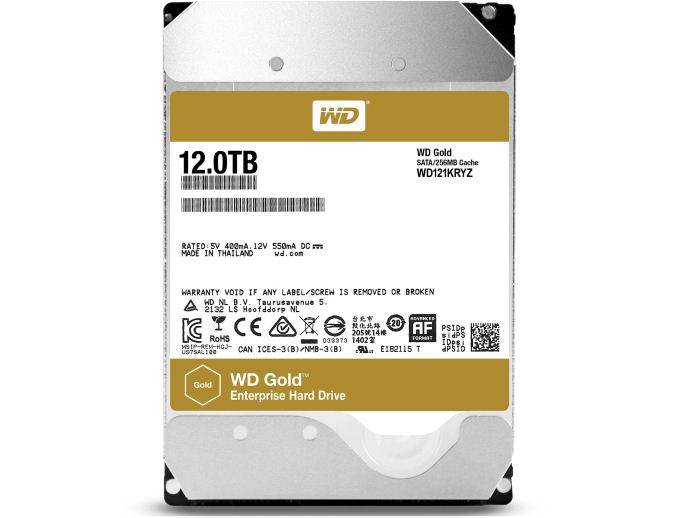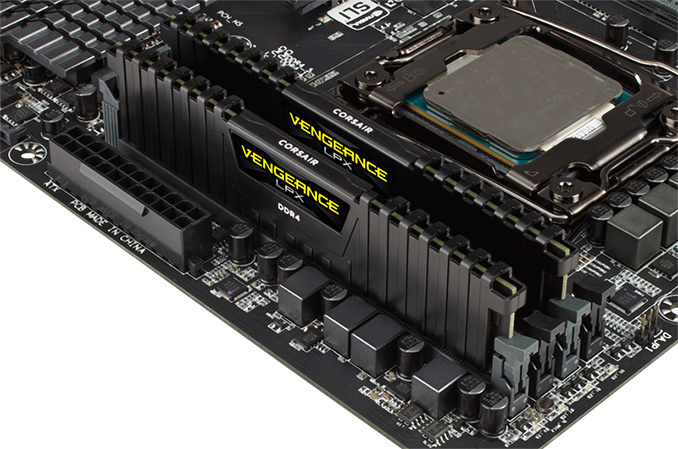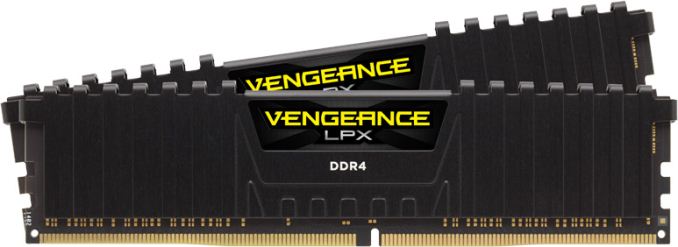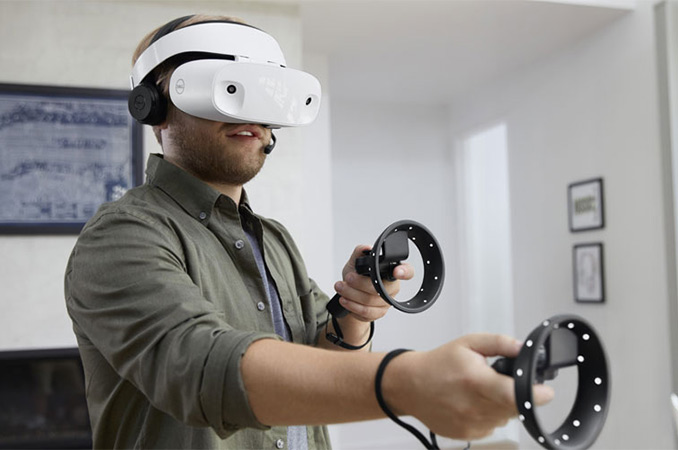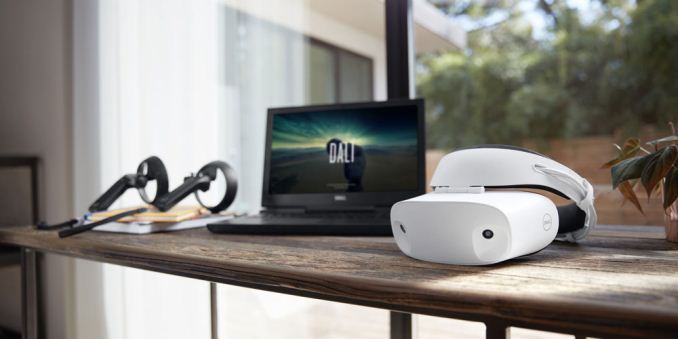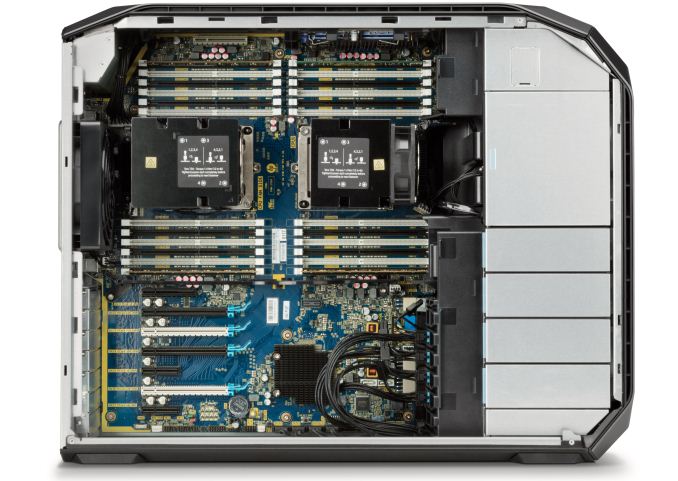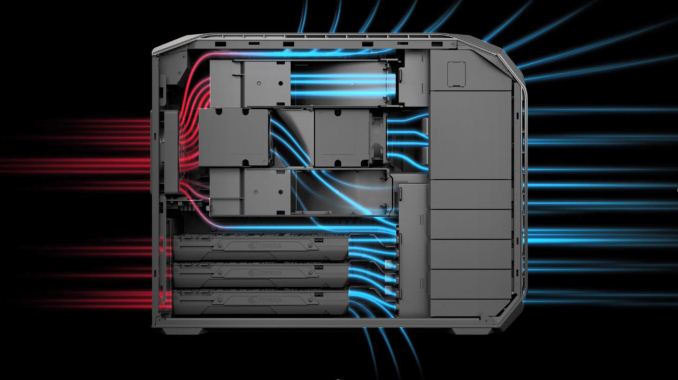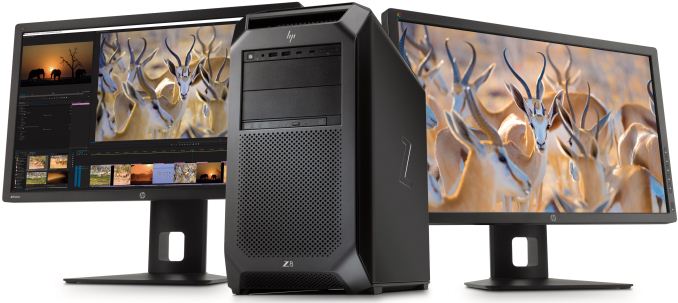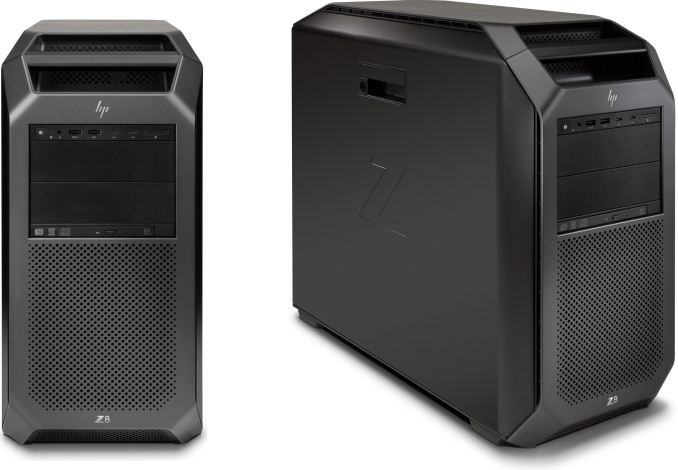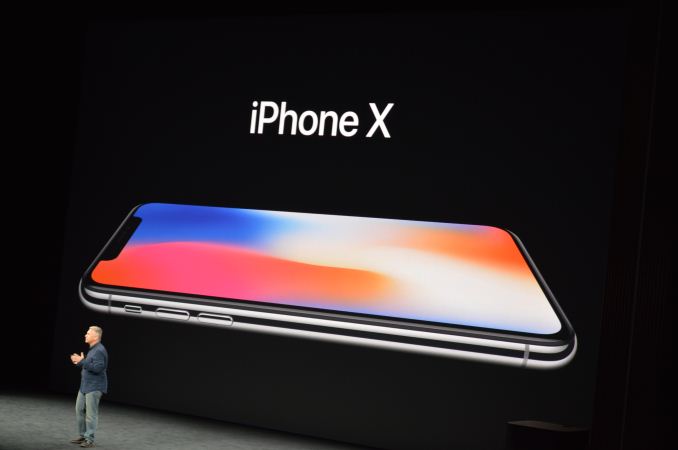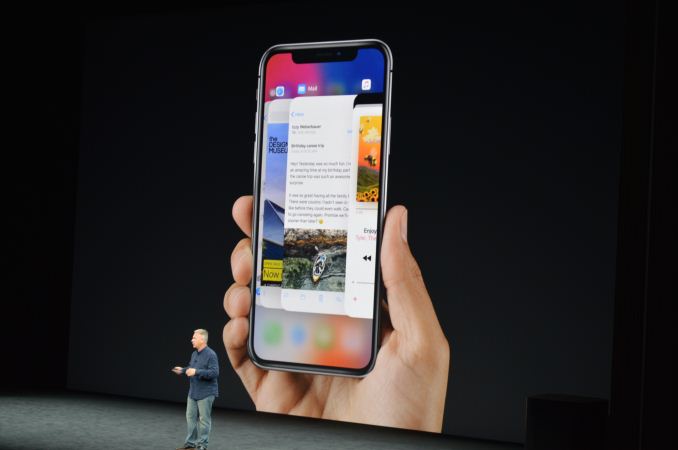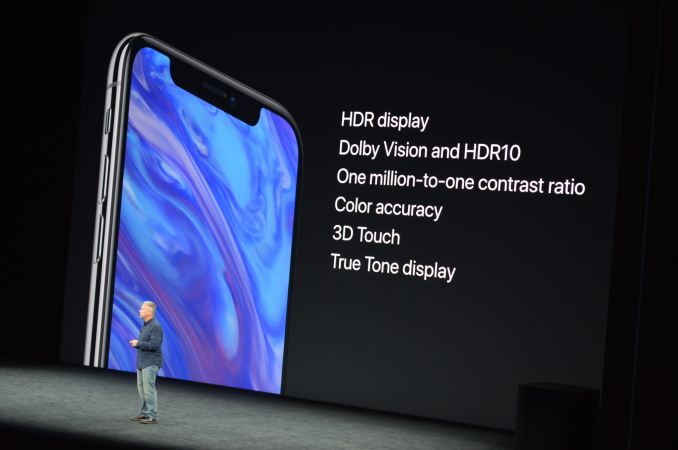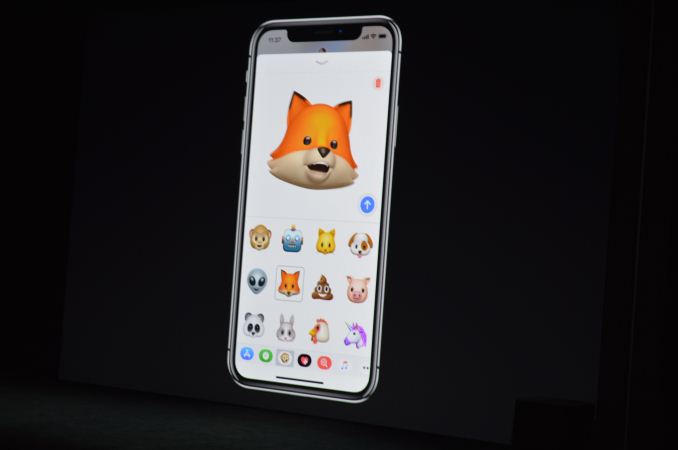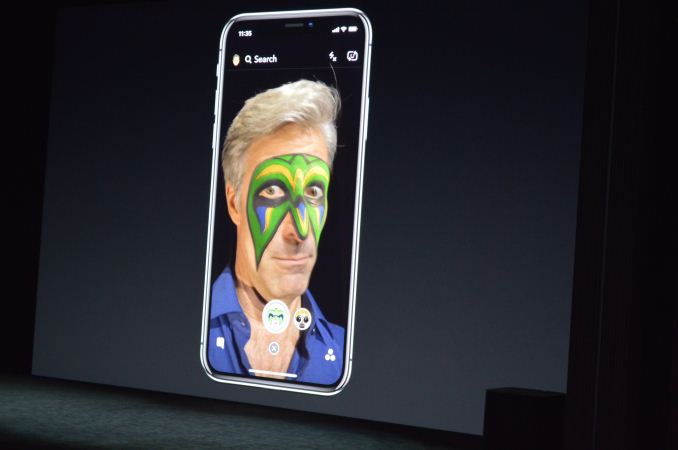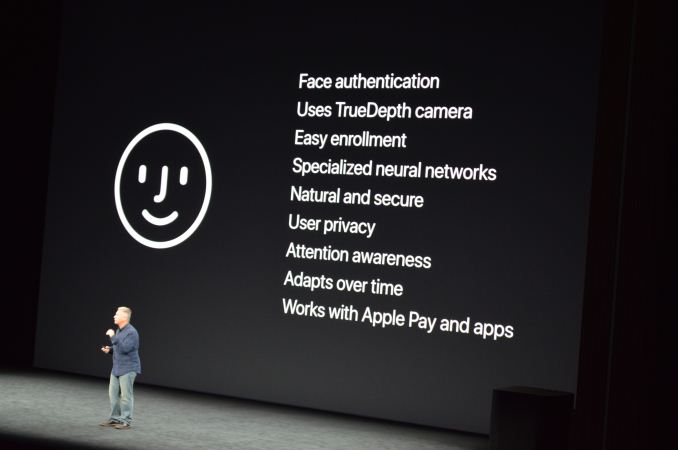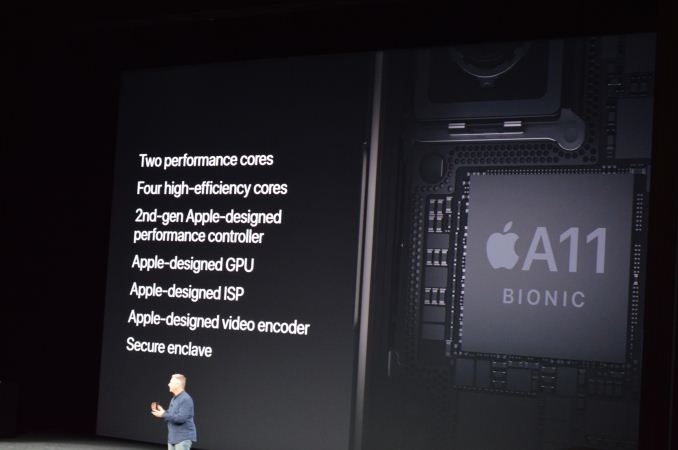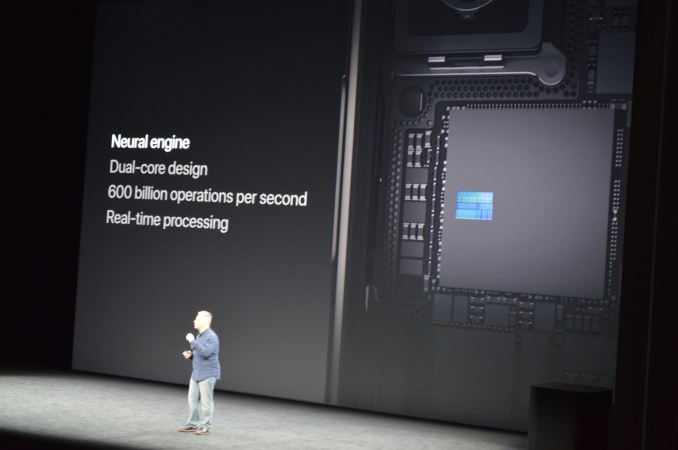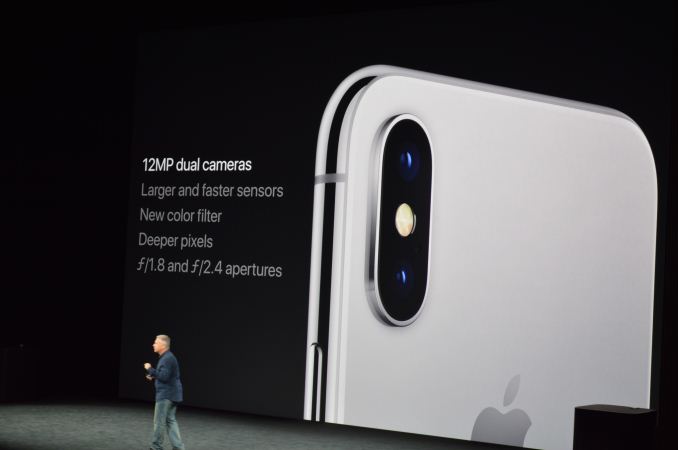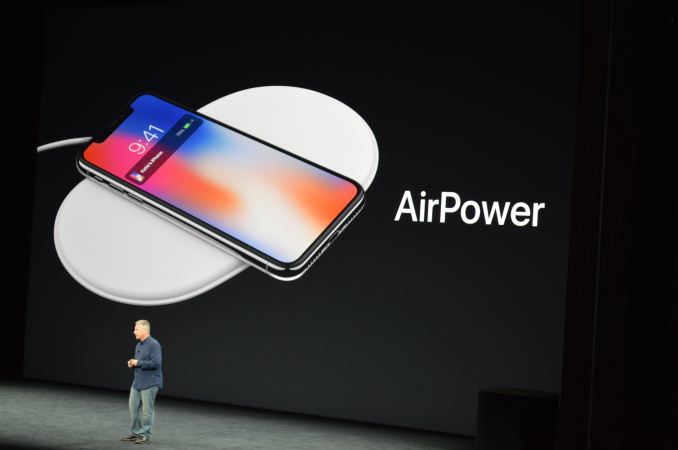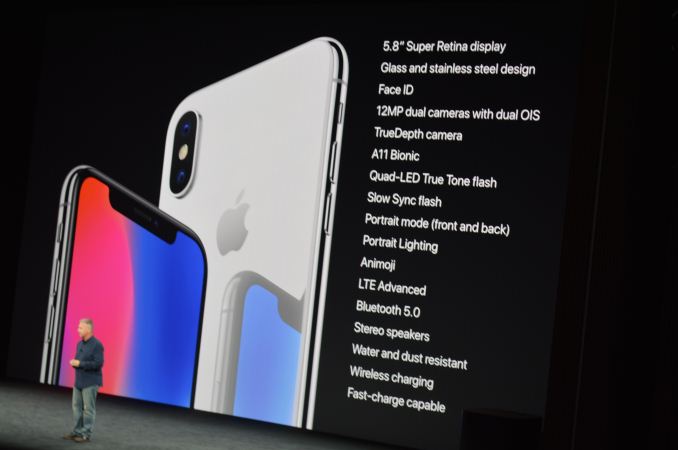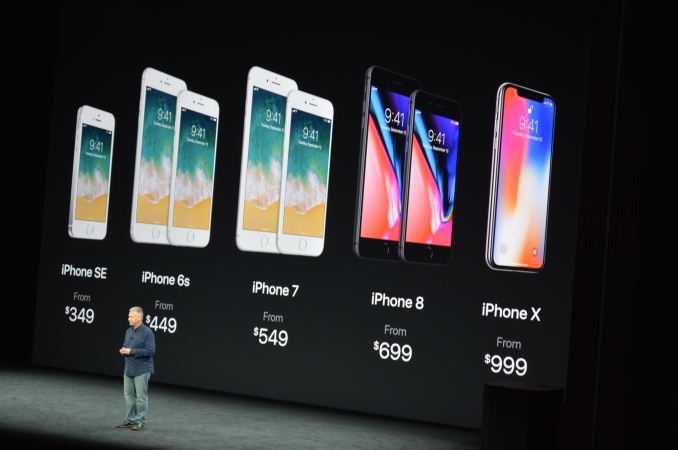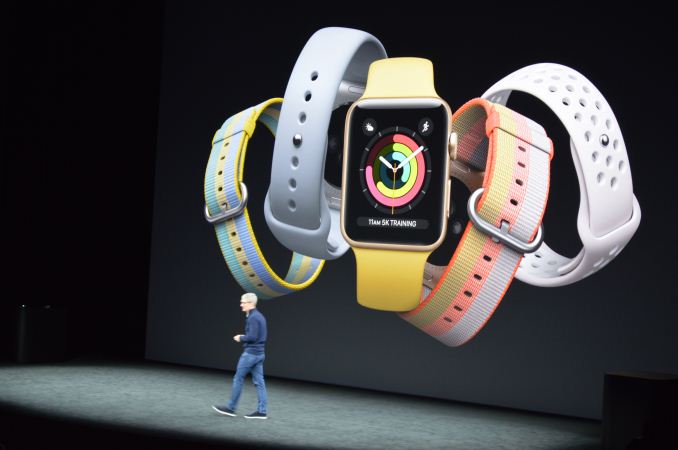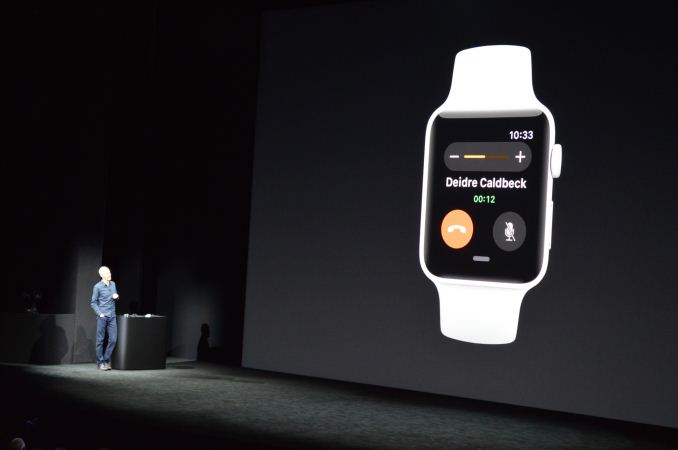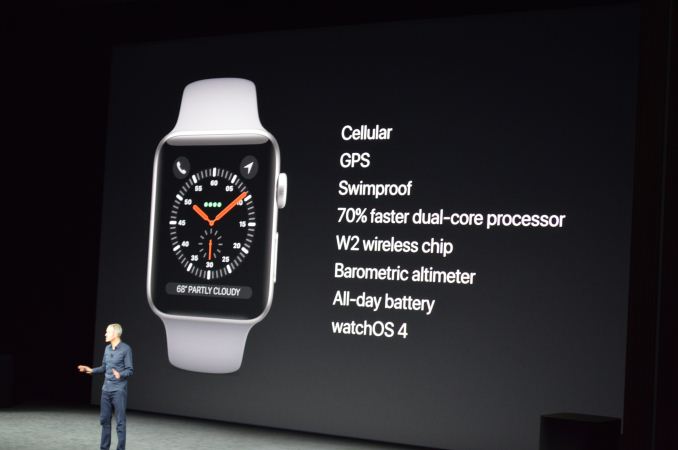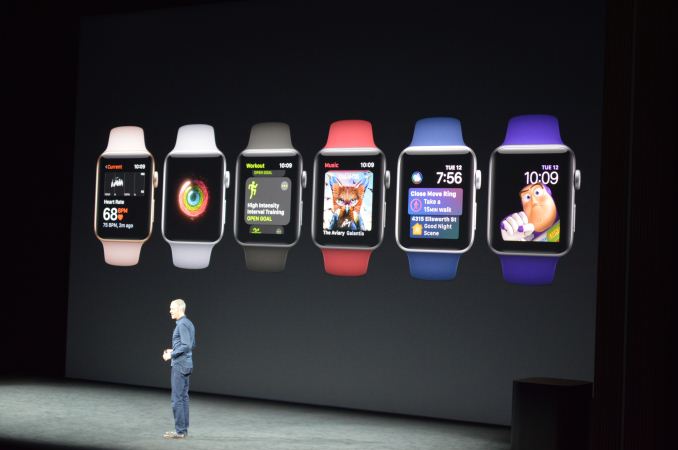Divers
AnandTech
-
Western Digital Ships 12 TB WD Gold HDD: 8 Platters and Helium
Western Digital has begun to ship its WD Gold HDD with 12 TB capacity to partners and large retailers. The 3.5” drive relies on the same platform as the HGST Ultrastar He12 launched this year, and will initially be available to select customers of the company. The WD Gold 12 TB is designed for enterprise workloads and has all the performance and reliability enhancements that we come to expect, but the availability at retail should make them accessible to wider audiences.
From a hardware point of view, the WD Gold 12 TB is similar to the HGST Ultrastar He12 12 TB hard drive: both are based on the fourth-generation HelioSeal technology that uses eight perpendicular magnetic recording platters with a 1.5 TB capacity for each platter. The internal architecture of both HDDs was redesigned compared to predecessors to accommodate the eighth platter. Since the WD Gold and the Ultrastar He12 are aimed at nearline enterprise environments, they are equipped with various sensors and technologies to protect themselves against vibration and as a result, guarantee sustained performance. For example, the WD Gold and the Ultrastar He12 attach their spindles both to the top and the bottom of the drives. In addition the HDDs feature a special technology that increases the accuracy of head positioning in high-vibration environments to improve performance, integrity, and reliability. Finally, both product families support TLER (time-limited error recovery) rebuild assist mode to speed up RAID recovery time.
Since the WD Gold 12 TB and the HGST Ultrastar He12 are similar internally and feature the same 7200 RPM spindle speed, they also have similar performance — the manufacturer puts them both at 255 MB/s sustained transfer rate and 4.16 ms average latency. The main difference between the WD Gold and the HGST Ultrastar He12 are the enterprise options for the latter: there are models with the SAS 12 Gb/s interface and there are models with SED support and Instant Secure Erase feature.
Comparison of Western Digital's WD Gold HDDs WD121KRYZ WD101KRYZ WD8002FRYZ WD6002FRYZ WD4002FRYZ Capacity 12 TB 10 TB 8 TB 6 TB 4 TB RPM 7200 RPM Interface SATA 6 Gbps DRAM Cache 256 MB 128 MB NAND Cache Unknown No Yes Unknown Helium-Filling Yes No Data Transfer Rate (host to/from drive) 255 MB/s 249 MB/s 205 MB/s 226 MB/s 201 MB/s MTBF 2.5 million Rated Annual Workload 550 TB Acoustics (Seek) - 36 dBA Power Consumption Sequential read 7 W 7.1 W 7.2 W 9.3 W 9 W Sequential write 6.8 W 6.7 W 7 W 8.9 W 8.7 W Random read/write 6.9 W 6.8 W 7.4 W 9.1 W 8.8 W Idle 5 W 5.1 W 7.1 W 7 W Warranty 5 Years Price as of September 9, 2017 MSRP $521.99 $410.99 $327.99 $244.99 $183.99 Per GB $0.0435 $0.0411 $0.041 $0.0408 $0.046 GB per $ 22.98 GB 24.33 GB 24.39 GB 24.48 GB 21.73 GB Western Digital aims its WD Gold and HGST Ultrastar He-series drives at operators of cloud and exascale data centers that demand maximum capacity. The 12 TB HDDs can increase the total storage capacity for a single rack from 2440 TB to 2880 TB, replacing 10 TB drives with 12 TB drives, which can be a major benefit for companies that need to maximize their storage capacity per watt and per square meter. Where the HGST-branded drives are made available primarily through B2B channels, the WD Gold are sold both through B2B and B2C channels and thus can be purchased by wider audiences. For example, boutique PC makers, as well as DIY enthusiasts, may start using the WD Gold 12 TB for their high-end builds, something they could not do with the HGST drives. These HDDs may be considered as an overkill for desktops, but since WD’s desktop offerings top at 6 TB, the WD Gold (and the perhaps inevitable future WD Red Pro 12 TB) is the WD’s closest rival for Seagate’s BarraCuda Pro drives.
The WD Gold HDD is currently available directly from Western Digital for $521.99 as well as from multiple retailers, including Newegg for $539.99. While over $500 for a hard drive is expensive, it is actually less than Western Digital charged for its WD Gold 8 TB about 1.5 years ago ($595) and considerably less than the initial price of the WD Gold 10 TB drive last April.
Related Reading:
- Western Digital: Sales of Helium-Filled HDDs Accelerating, 15M Sold So Far
- Western Digital Starts Shipments of HGST Ultrastar He12 12 TB HDDs
- Western Digital Expands Purple Lineup with a 10 TB Helium-Filled HDD
- Western Digital Announces Ultrastar He12 12 TB and 14 TB HDDs
- Western Digital Adds Helium-Filled WD Gold 10 TB HDD to Lineup
-
An AMD Threadripper X399 Motherboard Overview: A Quick Look at Seven Products
With the release of AMD’s Threadripper CPUs into the HEDT market, board partners have released new motherboards based on the X399 chipset. Consumers are going to see quad channel memory, native 4-Way SLI and Crossfire capabilities, more full-speed M.2 slots, added 10G network ports, and more on the new platform. We're taking a quick look at each of the motherboards that the vendors are promoting in the market, as well as a few upcoming teasers.
-
Corsair Announces 16GB DDR4-4600 Vengeance LPX DRAM Kits
Corsair on Thursday announced two fresh Vengeance LPX memory kits that set new performance records for the product family. The new dual-channel memory kits are intended for Intel’s Kaby Lake-X CPUs and Intel’s X299 platforms, and they operate at DDR4-4500 and DDR4-4600 MT/s data transfer rates and require over 1.4 V.
Corsair’s new fastest-ever DDR4 memory kits have a combined capacity of 16 GB and are rated for DDR4-4500 with CL19-19-19-39 timings at 1.45 V and for DDR4-4600 at CL19 26-26-46 at 1.5 V. Corsair verified stable performance of its DIMMs at transfer rates well beyond those recommended by JEDEC using an Intel Kaby Lake-X CPU and ASRock’s X299 OC Formula motherboard. The OC Formula motherboard only runs at one DIMM per channel (vs. 2 DPC on most X299 mainboards) in a bid to guarantee a “cleaner” data path and stable power supply to maximize overclocking potential for DRAM. Given the increased speeds and required overvoltage over the standard, the quality of the motherboard DRAM VRM becomes crucial for stability in case of DDR4-4500 and DDR4-4600 modules. For the same reason, Corsair does not equip its ultra-fast Vengeance LPX DIMMs with RGB LEDs because they may affect power supply and stability.
The new Corsair Vengeance LPX DDR4-4500 and DDR4-4600 memory kits are based on Samsung’s B-die, produced using 20 nm process technology. These memory ICs have been used by makers of leading-edge DDR4 memory modules (Corsair, G.Skill, GeIL, etc.) for a couple of years and by now they all know what to expect from these devices even in extreme conditions, such as operation with a 20 or 25% overvoltage.
The new Vengeance LPX memory modules from Corsair come with regular black aluminum heat spreaders that work well with all types of CPU coolers. The embedded XMP 2.0 SPD settings to make it easy for end users to set up correct timings and sub-timings.
Corsair's 'Extreme' Vengeance LPX Memory for Intel's X299 Platform Speed CL Timing Voltage Kit Capacity P/N DDR4-4500 CL19 19-19-39 1.45 V 2×8 GB 16 GB CMK16GX4M2F4500C19 DDR4-4600 CL19 23-23-43 1.5 V CMK16GX4M2F4600C19 Corsair’s new Vengeance LPX 16 GB (8 GB×2) DDR4-4500 and DDR4-4600 kits are going to hit the market in the coming days, and they are going to be expensive. The DDR4-4500 kit will retail at $479.99, whereas the DDR4-4600 kit will retail for $549.99.
Related Reading
- G.Skill Ups the Ante on Memory Speed and Voltage: 16 GB DDR4-4600 1.5v Kit for Kaby Lake-X
- G.Skill Announces Quad-Channel DDR4-4200 Kit for Intel Skylake-X CPUs
- DRAM and Motherboard Makers Demonstrate Quad-Channel DDR4-4000+ Operation
- The Corsair Neutron NX500 (400GB) PCIe SSD Review: Big Card, Big Pricetag
- Corsair’s ONE SFF PCs Get Upgraded: GeForce GTX 1080 Ti, 32 GB of RAM, NVMe SSD
- EagleTree and Partners Acquire Majority Stake in Corsair for $525 Million
-
Dell’s Visor Available for Pre-Order: A Mixed Reality Headset, Ships in Mid-October
Dell has begun to take pre-orders on its Visor headset for Windows Mixed Reality applications. The company will start shipments of the device in mid-October, just in time for Microsoft’s Windows 10 Creators Update that arrives on October 17 and ahead of the holiday season.
Starting from September 14, Dell’s Visor WMR headset is available for pre-order from Dell.com/Visor in the U.S. and from PCWorld in the U.K. The headset itself is priced at $349.99, the controller kit costs $99.99 and a Visor with controllers is priced at $449.99. In the U.K., the whole kit is available for pre-order at £429.99. In order to play non-controller based AR/VR games on the Visor, users will also have to get an Xbox One controller. Dell will start to ship its Visor product on October 17, 2017. In addition, the company plans to make the device available in BestBuy stores and directly from Microsoft (online and offline).
Dell’s Visor AR/VR headset complies with Microsoft’s requirements for headsets compatible with the Windows Mixed Reality platform: it connects to Windows 10-based PCs using HDMI and USB cables, it features two 1440×1440@90 Hz LCD panels (for a total resolution of 2880×1440) and two cameras to capture the outside world. While ergonomics and industrial designs of WMR-compliant headsets from Dell, Acer, ASUS and Lenovo are different, internally they end up being very similar.
The shipments date of the Dell Visor coincides with the launch date of Microsoft’s Windows 10 Creators Update, which will bring support for Windows Mixed Reality headsets to end users. That said it is highly likely that other makers of WMR gear will try to ship their products around the time of the official launch of the platform. In the meantime, Dell seems to be the first with pre-orders.
Related Reading
-
HP Updates Z8 Workstations: Up to 56 Cores, 3 TB RAM, 9 PCIe Slots, 1700W
HP has updated its most powerful dual-processor Z8 workstation line with the latest components. The new systems contain up to two Intel Skylake-SP Xeon CPUs with up to 56 cores in total, up to 3 TB of DDR4 RAM, terabytes of storage as well as up to 9 PCIe slots along with optional TB3 and 10 GbE support via add-in cards. The HP Z8 workstation will be the pinnacle of HP’s computers for personal and professional use and its price in high-end configurations will surpass even the top-of-the-range gaming PCs.
Historically, most high-end workstations relied on server platforms to support more than one CPU and thus offer higher performance than any consumer desktop. The emergence of dual-core and then multi-core CPUs a little more a decade ago changed the workstation market quite quickly and significantly. In a world with quad-core CPUs, 4-way workstations did not make a lot of sense for 99% of the users and therefore they quickly became extinct. Moreover, by now, even 2-way workstations became rare. Today, the vast majority of workstations use one multi-core CPU that provides enough compute horsepower for professional workloads, whereas GPU-based accelerators are used for tasks like simulations. Nonetheless, there are still users who need maximum x86 performance and who therefore require 2-way workstations — and the HP Z8 is aimed precisely at such users. While the Intel Xeon Scalable processors with extreme core count were developed primarily with servers in mind, the Z8 is a system that people put on their desks and therefore it has a number of specific requirements regarding noise levels, features, security, compatibility with components and so on.
One of the key components of all PCs is its microprocessor. When it comes to the HP Z8, it is based on up to two Intel Xeon Platinum 8180 with 28 cores and 205 W TDP each, which means that the system has to remove 410 W of thermal energy only from CPUs, and this requirement had a significant impact on the design of the whole system. The company did not want to use a liquid cooling system, so it had to design an air cooling solution capable of cooling down two extremely hot CPUs as well as up to 24 DDR4-2666 memory modules. Each processor has its own radiator equipped with a high-pressure air fan (which speed is regulated by BIOS in accordance with system temperature monitored by numerous sensors). In addition, the system has multiple airflow vents on the front and on the top as well as one fan that exhausts hot air on the back. According to HP, such a chassis architecture ensures that the second CPU does not re-use warm air from the first one, but since they are located in close proximity, one will always affect another with its heat. Finally, the system has additional fans that cool down other components and produce more airflow within the chassis.
Speaking of other components, the HP Z8 supports plenty of them — whatever one might want. First off, the system has four PCIe 3.0 x16 slots for graphics cards or SSDs (up to AMD Radeon Pro, NVIDIA Quadro P100 or GP100, up to 4 TB HP Z Turbo Drive Quad Pro, etc.) three PCIe 3.0 x8 (two are non-hot swap) slots for SSDs and two PCIe 3.0 x4 slots. In addition to PCIe-based storage, the Z8 also features four 2.5”/3.5” bays for SATA/SAS SSDs or HDDs as well as two external 5.25” bays that can also accommodate drive form-factor storage devices using appropriate adapters. Those who need it, HP may also install an SD card reader as well as a slim DVD or Blu-ray ODD.
When it comes to connectivity, the HP Z8 has all the bases covered. By default, the system supports two GbE connectors (powered by Intel controllers), an 802.11ac Wi-Fi + Bluetooth module (Intel Wireless-AC 8265 controller), two USB 3.1 Type-C ports and two USB 3.1 Type-A ports on the front, four USB 3.1 Type-A ports on the back, multi-channel audio connectors (a Realtek HD ALC221 controller) on the back, a TRRS audio connector on the front and so on. Meanwhile, owners can optionally order to install two 10 GbE controllers, a Thunderbolt 3-supporting add-in-card and a variety of custom components for various industries and workloads (an external audio solution for a 5.25” bay, for example).
Since many businesses and enterprises require robust security for all of their machines, the HP takes everything seriously and ships the Z8 with a whole set of security features that it calls HP SureStart. The system features secure authentication, full volume encryption, TPM 2.0, has a Kensington lock and so on.
All the CPUs, GPUs, SSDs and other components require a lot of power and HP Z8 has plenty of it. The manufacturer offers 1125 W, 1450 W or 1700 W internal PSUs with up to 90 % efficiency. The PSU is located in a compartment behind the motherboard, so chances are that HP uses proprietary units.
General Specifications of the HP Z8 2017 HP Z8 G4 CPU Family Intel Xeon Scalable processor Models Xeon Platinum 8180 (2.5GHz/3.8GHz, 38.5MB cache, 28 cores)
Xeon Platinum 8160 (2.1 GHz/3.7 GHz, 33 MB cache, 24 cores)
Xeon Gold 6152 (2.1 GHz/3.7 GHz, 30.25 MB cache, 22 cores)
Xeon Gold 6154 (3 GHz/3.7 GHz, 24.75 MB cache, 18 cores)
Xeon Gold 6148 (2.4 GHz/3.7 GHz, 27.5 MB cache, 20 cores)
Xeon Gold 6142 (2.6 GHz/3.7 GHz, 22 MB cache, 16 cores)
Xeon Gold 6136 (3 GHz/3.7 GHz, 24.75 MB cache, 12 cores)
Xeon Gold 6140 (2.3 GHz/3.7 GHz, 24.75 MB cache, 18 cores)
Xeon Gold 6134 (3.2 GHz/3.7 GHz, 24.75 MB cache, 8 cores)
Xeon Gold 6132 (2.6 GHz/3.7 GHz, 19.25 MB cache, 14 cores)
Xeon Gold 6130 (2.1 GHz/3.7 GHz, 22 MB cache, 16 cores)
Xeon Gold 6128 (3.4 GHz/3.7 GHz, 19.25 MB cache, 6 cores)
Xeon Gold 5120 (2.2 GHz/3.2 GHz, 19.25 MB cache, 14 cores)
Xeon Gold 5118 (2.3 GHz/3.2 GHz, 16.5 MB cache, 12 cores)
Xeon Gold 5122 (3.6 GHz/3.7 GHz, 16.5 MB cache, 4 cores)
Xeon Silver 4116 (2.1 GHz/3 GHz, 16.5 MB cache, 12 cores)
Xeon Silver 4114 (2.2 GHz/3 GHz, 13.75 MB cache, 10 cores)
Xeon Silver 4112 (2.6 GHz/3 GHz, 8.25 MB cache, 4 cores)
Xeon Silver 4108 (1.8 GHz/3 GHz, 11 MB cache, 8 cores)
Xeon Bronze 3106 (1.7 GHz, 11 MB cache, 8 cores)
Xeon Bronze 3104 (1.7 GHz, 8.25 MB cache, 6 cores)Graphics Entry NVIDIA Quadro P400 (2 GB GDDR5)
NVIDIA Quadro P600 (2 GB GDDR5)
AMD FirePro W2100 (2 GB DDR3)Mid-Range NVIDIA Quadro P1000 (4 GB GDDR5)
NVIDIA Quadro P2000 (5 GB GDDR5)
AMD Radeon Pro WX 3100 (4 GB GDDR5)
AMD Radeon Pro WX 4100 (4 GB GDDR5)High-End NVIDIA Quadro P4000 (8 GB GDDR5)
AMD Radeon Pro WX 7100 Graphics (8 GB GDDR5)Ultra High-End NVIDIA Quadro P5000 (16 GB GDDR5X)
NVIDIA Quadro P6000 (24 GB GDDR5X)
AMD Radeon Pro WX 9100 Graphics (16 GB HBM2)
NVIDIA Quadro GP100 (16 GB HBM2)RAM 24 DDR4 DIMMs, up to 1.5 TB of DDR4-2666
(3TB options in H1 2018, when M CPUs are available)Storage Bays 4 × 2.5"/3.5", 2 × 5.25", 1 × slim 5.25" for ODDs Options 300 GB SAS (15000 rpm)
500 GB up to 2 TB SATA (7200 rpm)
500 GB SATA SED (7200 rpm)
1 TB up to 4 TB 7200 rpm SATA Enterprise
256 GB up to 2 TB SATA SSD
256 GB up to 512 GB SATA SED Opal 2 SSD
240 GB up to 480 GB SATA Enterprise SSD
256 GB up to 1 TB HP Z Turbo Drive PCIe SSD M.2
256 GB up to 512 GB HP Z Turbo Drive PCIe SED SSD M.2
256 GB up to 4 TB HP Z Turbo Drive Quad Pro PCIe SSD
HP Slim DVD-ROM
HP Slim Blu-ray Writer
HP Slim DVD-WriterNetworking GbE Integrated Intel I219-LM PCIe GbE
Integrated Intel X722 PCIe GbE
Intel I350-T2 dual-port GbE NIC
Intel I350-T4 dual-port GbE NIC
Intel I210-T1 PCIe GbE10 GbE Intel X550-T2 dual-port GbE NIC
Intel X710-DA2 dual-port GbE NIC
Intel 10 GbE SFP+ SR transceiver
HP dual-port 10GBase-T NICWireless Intel Dual Band Wireless-AC 8265 802.11a/b/g/n/ac (2x2) Wi-Fi and Bluetooth 4.2 Combo, non-vPro PCIe 3.0
Expansion Slotsx4 2 x8 3 x16 4 Notes 1 PCIe x8 has rear bulkhead access and 2 PCIe x8 are internal access only. Slot 1: Transforms to PCIe x8 when 2nd CPU is installed.
Slots 3 and 6: are available only when 2nd processor is installed.
PCIe x16 - Available only when 2nd processor is installedUSB 3.1 2 × Type-A, 2 × Type-C 3.0 4 × Type-A 2.0 unknown Thunderbolt Optional Thunderbolt 3 add-in-card Card Reader 4-in-1 card reader PSUs 1125 W, 1450 W, 1700 W Other I/O Audio connectors, Realtek HD ALC221 controller Input Devices HP Wireless Business Slim Keyboard and Mouse Combo
HP USB Business Slim Keyboard
USB Premium wired keyboard
USB Smart Card (CCID) keyboard
3Dconnexion CADMouse
HP USB Optical Mouse
HP PS/2 Mouse
HP USB Hardened MouseDimensions 8.5 × 21.7 × 17.5 in
21.59 × 55.12 × 44.45 cmWeight Starting at 49.4 lb
Starting at 22.4 kgOperating System Windows 10 Pro for Workstations
HP Installer Kit for Linux
HP Red Hat Enterprise LinuxPrice Starting at $2,439 Now, time to talk about availability and pricing. HP intends to ship the HP Z8 workstations in October. An entry-level model with one CPU, a basic GPU and storage will cost $2,439. Meanwhile, once the system is equipped with two Xeon Platinum 8180 CPUs, NVIDIA Quadro P100/GP100 graphics, multiple PCIe SSDs, 3 TB of DDR4 memory, several 12 TB HDDs and various advanced I/O capabilities (TB3, 10 GbE, etc.), its price will easily hit tens of thousands of dollars.
It's normally at this point that a vendor such as HP states that the high-end models are likely to be sold under B2B contracts, where per-unit costs are not as severe. One OEM has told us that only 5% of sales of their high-end workstations come through direct sales for onlike pricing.
Gallery: HP Updates Its Dual-Processor Z8 Workstation: Up to 56 Cores, 3 TB RAM, 9 PCIe Slots, 1700WRelated Reading
- HP Announces Omen X Laptop: 17.3” LCD, Core i7 + GeForce GTX with Overclocking
- HP Expands Commercial VR Strategy: Z VR Backpack and Immersion Centers
- HP Launches Elite x2 1012 G2 2-in-1: 12.3-Inch Display, Kaby Lake, 1 TB SSD, 16 GB LPDDR3, TB3
- HP Z2 Mini G3 Announced: Miniature Professional Workstation with Xeon and Quadro
- HP Introduces HP ENVY 13 Laptops with Kaby Lake, USB-C, New Battery, $849
- HP Updates The Z240 Workstation With The Core i7-6700K
-
TSMC Teams Up with ARM and Cadence to Build 7nm Data Center Test Chips in Q1 2018
TSMC has announced plans to build its first test chips for data center applications using its 7 nm fabrication technology. The chip will use compute cores from ARM, a Cache Coherent Interconnect for Accelerators (CCIX), and IP from Cadence (a DDR4 memory controller, PCIe 3.0/4.0 links). Given the presence of the CCIX bus and PCIe 4.0 interconnects, the chip will be used to show the benefits of TSMC’s 7 nm process primarily for high-performance compute (HPC) applications. The IC will be taped out in early Q1 2018.
The 7 nm test chips from TSMC will be built mainly to demonstrate capabilities of the semiconductor manufacturing technology for performance-demanding applications and find out more about peculiarities of the process in general. The chip will be based on ARMv8.2 compute cores featuring DynamIQ, as well as a CMN-600 interconnect bus for heterogeneous multi-core CPUs. ARM and TSMC do not disclose which cores they are going to use for the device - the Cortex A55 and A75 are natural suspects, but that’s a speculation at this point. The new chip will also have a DDR4 memory controller as well as PCI Express 3.0/4.0 links, CCIX bus and peripheral IP buses developed by Cadence. The CCIX bus will be used to connect the chip to Xilinx’s Virtex UltraScale+ FPGAs (made using a 16 nm manufacturing technology), so in addition to implementation of its cores using TSMC’s 7 nm fabrication process, ARM will also be able to test Cadence’s physical implementation of the CCIX bus for accelerators, which is important for future data center products.
TSMC's 7 nm Test Chip at Glance Logic PHY Compute Cores ARM v8.2 with DynamIQ Internal Interconnect Bus ARM CMN-600 CCIX Cadence DDR4 DRAM Controller ? Cadence PCI Express 3.0/4.0 Cadence Peripheral Buses I2C, SPI and QSPI by Cadence Verification and Implementation Tools Cadence As reported multiple times, TSMC’s 7 nm manufacturing process will be a “long” node and the foundry expects the majority of its large customers to use it. By contrast, the current 10 nm technology is aimed primarily at developers of smartphone SoCs. TSMC projects that its first-generation CLN 7FF fabrication technology, compared to its CLN16FF+, will enable its customers to reduce power consumption of their chip by 60% (at the same frequency and complexity), increase their clock rate by 30% (at the same power and transistor count) and shrink their die sizes by 70% at the same complexity. Sometime in 2019, TSMC plans to start making chips using its CLN7FF+ process technology with EUV for critical layers. TSMC claims that the CLN7FF+ will enable the company’s customers to further increase transistor density while improving other areas, such as yields and power consumption.
TSMC does not disclose which of its 7 nm process technologies announced so far it is going to use for the test chip, but the use of EUV for test chips is something that cannot be excluded. For example, GlobalFoundries claims that they use EUV to accelerate production of test chips. On the other hand, since design rules for CLN7FF and CLN7FF+ are different, it is highly likely that TSMC conservatively uses the former for the test chip.
TSMC’s CLN7FF process tech passed qualification in April and was expected to enter risk production in Q2 2017, according to TSMC’s management. The foundry expected 13 CLN7FF tape outs this year and it is projected that the fabrication technology would be used commercially starting from Q2 2018. Therefore, taping out the test vehicle using the first-gen DUV-only 7 nm process in Q1 2018 seems a bit late for early adopters who intend to ship their 7 nm SoCs in the second half of next year. Meanwhile, early adopters (read: Apple, Qualcomm, and some others) get access to new process technologies long before their development is completed and final PDKs (process development kits) are ready. Keeping in mind that the test chips feature a CCIX and PCIe 4.0 buses, it is clearly designed to show advantages of TSMC’s 7 nm process technologies for HPC applications. In fact, this is what TSMC says itself:
“Artificial intelligence and deep learning will significantly impact industries including media, consumer electronics and healthcare,” said Dr. Cliff Hou, TSMC vice president, Research & Development/Design and Technology Platform. “TSMC’s most advanced 7nm FinFET process technology provides high performance and low power benefits that satisfy distinct product requirements for High-Performance Computing (HPC) applications targeting these markets.”
Related Reading
- GlobalFoundries Details 7 nm Plans: Three Generations, 700 mm², HVM in 2018
- Intel to Equip Fab 42 for 7 nm
- Samsung and TSMC Roadmaps: 8 and 6 nm Added, Looking at 22ULP and 12FFC
- ARM Launches DynamIQ: big.Little to Eight Cores Per Cluster
- ARM Announces Mali-G72: Bifrost Refined for the High-End SoC
- ARM Announces Mali-G72: Bifrost Refined for the High-End SoC
-
One Design, Two Products: The SanDisk Ultra 3D (1TB) and WD Blue 3D (1TB) SSD Reviews, with BiCS 3D NAND
The first 3D NAND SSDs from Western Digital and its SanDisk subsidiary have arrived. The same mainstream SATA SSD with 3D TLC is being sold under two names, but either way it is a big step forward: SanDisk's 64-layer BiCS3 3D NAND enables faster performance and lower power consumption.
-
Raja Koduri, Head of AMD's RTG, to go on Sabbatical until December
Late last night, PC Perspective confirmed rumors that Raja Koduri, AMD's Radeon Technologies Group (RTG) Senior Vice President and Chief Architect, is to go on sabbatical. Sourcing Raja’s internal letter to the RTG team, he will be taking leave from September 25 until an unspecified date in December, to spend time with his family. Dr Lisa Su, AMD's CEO, will lead RTG in the interim.
As reproduced by Ryan Shrout, Raja’s letter is as follows:
RTG Team,
You haven’t heard from me collectively in a while – a symptom not only of the whirlwind of launching Vega, but simply of the huge number of demands on my time since the formation of RTG. Looking back over this short period, it is an impressive view. We have delivered 6 straight quarters of double-digit growth in graphics, culminating in the launch of Vega and being back in high-performance. What we have done with Vega is unparalleled. We entered the high-end gaming, professional workstation and machine intelligence markets with Vega in a very short period of time. The demand for Vega (and Polaris!) is fantastic, and overall momentum for our graphics is strong.
Incredibly, we as AMD also managed to spectacularly re-enter the high-performance CPU segments this year. We are all exceptionally proud of Ryzen, Epyc and Threadripper. The computing world is not the same anymore and the whole world is cheering for AMD. Congratulations and thanks to those of you in RTG who helped see these products through. The market for high-performance computing is on an explosive growth trajectory driven by machine intelligence, visual cloud, blockchain and other exciting new workloads. Our vision of immersive and instinctive computing is within grasp. As we enter 2018, I will be shifting my focus more toward architecting and realizing this vision and rebalancing my operational responsibilities.
At the beginning of the year I warned that Vega would be hard. At the time, some folks didn’t believe me. Now many of you understand what I said. Vega was indeed hard on many, and my sincere heartfelt thanks to all of you who endured the Vega journey with me. Vega was personally hard on me as well and I used up a lot of family credits during this journey. I have decided to take a time-off in Q4 to spend time with my family. I have been contemplating this for a while now and there was never a good time to do this. Lisa and I agreed that Q4 is better than 2018, before the next wave of product excitement. Lisa will be acting as the leader of RTG during by absence. My sincere thanks to Lisa and rest of AET for supporting me in this decision and agreeing to take on additional workload during my absence.
I am looking to start my time-off on Sept 25th and return in December.
Thank you, all of you, for your unwavering focus, dedication and support over these past months, and for helping us to build something incredible. We are not done yet, and keep the momentum going!
Regards, Raja
Since his return to AMD in 2013 and the reformation of a monolithic graphics division with RTG in 2015, Raja has overseen and led all aspects of AMD graphics hardware and software. Raja’s public presence and involvement render him the face of graphics at AMD, in all senses of the word, from Capsaicin events to Twitter and Reddit. Following Vega’s launch, Raja had taken two weeks vacation to visit family, following visits to company sites in India.
Given the news in his letter, we hope all is well.
-
Apple 2017: The iPhone X (Ten) Announced
The hot button item expected to come from Apple’s announcement today was the set of iPhones being announced. The iPhone 8 and iPhone 8 Plus were the expected models to come to market, but Apple felt that for the 10-year anniversary since the launch of the original iPhone, it should release a new model which ‘breaks the standard for another 10 years’. This new iPhone X device goes all in on some significant features that are novel to the Apple smartphone ecosystem: an edge-to-edge OLED display, a TrueDepth front-facing camera system, removal of TouchID in favor of a new facial recognition system called FaceID, and a few new features surrounding the integrated neural engine inside the A11 SoC.
The iPhone X (pronounced iPhone Ten) is a visually significant departure from previous Apple smartphones. The 5.8-inch display is called an ‘edge-to-edge’ display in the marketing material, citing minimal bezels and taking up pretty much the full real estate of the phone. Apple also dubs this as a new retina display, specifically a ‘Super Retina’ display, with a 2436x1125 resolution with a pixel density of 458 PPI. The display is Apple’s first foray into OLED technology on a smartphone, as ‘previous versions of OLED were not sufficient’ in previous generations. This means that Apple is promoting features such as HDR10 for high dynamic range, a 1000000:1 contrast ratio, and high color accuracy. That contrast ratio is due to the blacks provided by the OLED display, although it will be interesting to see what the practical limits are. Apple has always been consistent with having superb color accuracy on its smartphones, so we will have to see in our testing if OLED changes things in Apple’s qualification process. Also Apple’s TrueTone technology makes its way from the iPad to the iPhone. This display technology uses data from the ambient light sensor to detect the ambiance of the surroundings and adjust colors (particularly when reading black on white) and adjusting the display to make it easier to read. The display will also support 3D Touch.
With Apple moving to a full-screen technology like this, there is no room for the standard Home button, and with it, TouchID. As a replacement/upgrade, Apple is implementing FaceID: a set of front-facing technologies that will develop a face-map of a user and embed that as the passcode. This functionality is likely derived from Apple’s acquisitions of PrimeSense in 2013 (the IP behind Microsoft Kinect) and FaceShift in 2015. Apple states that the technology uses its embedded neural network engine to speed up facial recognition, but also that algorithms are in place such that the system will work if a user puts on glasses, wears a hat, has different hair, and even in low light. The algorithms will also auto-update as a user grows a beard. A lot of security researchers have questioned this move, while Apple quotes that the possibility for a false positive on TouchID was around 50k-to-1, FaceID should be more similar to a million-to-one. With FaceID, users will be able to unlock the device, as well as use their face to preapprove ApplePay purchases before touching a pay pad.
In order to enable FaceID, Apple implemented a small top area for the main hardware. This includes an infrared camera, a flood illuminator, the front camera, and a dot projector. The hardware will map the face in three dimensions with a 5-second startup (when in sufficient light) to produce a face mesh. One version of the mesh, with the textures as part of the algorithm, will be held in a secure enclave for identification and approval. At this point in time, only one face per device can be registered, marking an initial limitation in the hardware. One of the other features for the technology shown by Apple was the ability to generate a face mesh and map new textures to it, such as new SnapChat ‘masks’, or animated emoji in Message. The hardware will map 50 muscle tracking points, and a user can choose one of twelve animal emoji (fox, cat, dog, pig, unicorn, poop emoji) and record a ten second message where the ‘ani-moji’ will mimic in real-time how the user is moving and speaking in order to send to the other person. Apples plan here is to open the resources up to developers to use in their own applications.
Because the FaceID hardware is essentially an indent into the display, there will be some issues on content that will have to be addressed. On the home screen, Apple has designed the top icons to be inside the two nooks either side of the FaceID hardware, and adjust as needed. As shown by several journalists on the show floor at the launch event, the video will naturally default to fit perfectly without the little nooks, but if a user selects full screen, it will wrap around the FaceID hardware and intrude into the video being watched. Apple usually prides itself in the simplicity in its display support, and this might be a little scratch in that armor.
With no home button, Apple is having to implement new interactions to deal with regular home button actions. To wake the phone from a screen off state, a user can tap on the display (or use FaceID if setup). To get to the home screen, the user can swipe up in any application, although this seems a bit fraught with issues, especially with games where swiping up is a key mechanic of the application. In order to get the list of applications in memory, then swipe up but hold the finger down on the screen. Apple neglected to mention how to put the phone to sleep / screen off mode – there is a button on the side, but that is specifically for Siri. In order to get the notifications menu, swipe down from the top.
Under the hood, Apple is using its new A11 Bionic processor, with significant upgrades over the A10 and A10X. Details were scarce, but this is a TSMC 10nm design featuring six cores: two high-performance cores and four power efficient cores, with all six cores available for use at the same time. Apple is quoting that the high-performance cores are 25% faster than the high-performance cores in A10, while the high-efficiency cores are 70% faster than their counterparts in A10. No speeds are details about the cores were provided, though some initial analysis online from the code base suggests that the larger cores have two levels of private cache, while the smaller cores only have one level of private cache, with a high level of shared cache between both sets before hitting the DRAM. The A11 SoC will come in at 4.3 billion transistors, and features Apple’s second generation performance controller to assist with the 2+4 configuration. Also involved is a new GPU, which Apple states is its own custom design, coming in at ‘three cores’ (whatever that means in this context) and offers 30% higher performance than the graphics in the A10. Apple also stated that it can offer A10 graphics for half the A10 power, and that the GPU can assist in machine learning. We’ve seen discussions on Apple’s Metal 2 compute already appear at WWDC, so this is likely what Apple is talking about. The SoC also features a new ‘Neural Engine’ inside, offering two cores and 600 Giga-Ops per second, although no information as to how this inference hardware operates or at what precision (for example, Huawei’s NPU gives 1.92 TFLOPs of FP16). Apple was very light on A11 details, so we’ll likely revisit this topic later with more details.
For the camera system, Apple is using a vertical dual camera on the rear of the iPhone X, rather than the horizontal cameras on the iPhone 7 Plus and iPhone 8 Plus. Both of these cameras are new models, both are 12 megapixels, and both come with optical image stabilization. One camera is f/1.8, while the other is f/2.4, with both having larger and faster sensors with deeper pixels than previous iPhones to aid in image focus. Like with the iPhone 8 and iPhone 8 Plus, Apple will use the embedded Neural Engine to assist with photo taking, such as adjusting skin-tone mapping in real-time depending on the environment. The camera also supports dual Quad-LED flash.
The full design is glass on the back and front, using a new technology that Apple is quoting as the most shatter-resistant glass on an iPhone, and the band in the device will be ‘surgical grade stainless steel’ rather than aluminum. The iPhone X will be dust and water resistant, although Apple stopped short of giving it a full IPXX rating. Due to the glass, Apple is equipping the iPhone X with wireless charging capabilities using the Qi standard, and will offer a large ‘Air Power’ pad in 2018 that will allow users to wireless charge the iPhone X, the new Apple Watch Series 3, and the Air Pods all at the same time. Apple did not go into the size of the battery, although it does quote it as having two hours more battery life than the iPhone 7, despite the large OLED display.
Lots of features that we’ve seen discussed in previous Apple launches were glossed over here: changes in the haptic feedback, anything about audio (there’s no 3.5mm jack, if you were wondering), any hard performance metrics, SoC details about the cores and how/if they are different, or frequencies, or how the Neural Engine is laid out, or even how much DRAM is in the device. This is likely due to the fact that even for a two-hour presentation, time was spent detailing the new features more than the underlying hardware. Unlike other smartphone vendors or chip designers, Apple doesn’t do a deeper ‘Tech Day’ on their hardware, which is a shame.
What we do know is that Apple will be offering two storage options, 64GB and 256GB, and two colors in Space Grey and Silver (both of which have a slight pearlescence, according to Apple). The 64GB model will start at $999, and include Ear Pods in the box. The 256 GB model will have some markup, although Apple did not disclose how much. The iPhone X will go up for pre-order on October 27th in around 30 countries, and ship on November 3rd.
Additional: turns out there are a lot more specifications on Apple's product page that just went live. Key features are screen brightness (625 nits), dimensions (143.6 x 70.9 x 7.7 mm, 174 grams), native FLAC support and HDR video playback support. The 256 GB model will start at $1149, putting a $150 mark-up on the higher capacity, and the Lightning-to-3.5mm cables are still included in the box.
Apple iPhone iPhone 7 iPhone 7 Plus iPhone 8 iPhone 8 Plus iPhone X SoC Apple A10 Fusion
2 x 2.3 GHz Hurricane
2 x little coresApple A11 Bionic
2 x High-Perf
4 x High EfficiencyGPU 6 Core PowerVR GPU 3-Core Apple Custom Display 4.7-inch
1334 x 750
IPS LCD
DCI-P35.5-inch
1920 x 1080
IPS LCD
DCI-P34.7-inch
1334 x 750
IPS LCD
DCI-P35.5-inch
1920 x 1080
IPS LCD
DCI-P35.8-inch
2436x1125
OLED
DCI-P3Size / Mass 138.3 x 67.1 x 7.1 mm
138 grams158.2 x 77.9 x 7.3 mm
188 grams138.4 x 67.3 x 7.3 mm
148 grams158.4 x 78.1 x 7.5 mm
202 grams143.6 x 70.9 x 7.7mm
174 gramsBattery 1960 mAh
(7.55Whr)2900 mAh
(11.17Whr)? ? +2hr over iPhone 7 Wireless Charging - - Qi Qi Qi Rear Cameras 12 MP f/1.8, OIS
Wide Color Gamut
Quad LED True Tone Flash12 MP, f/1.8, OIS
Wide Color Gamut
Quad LED True Tone Flash- 12MP ƒ/2.8 Telephoto,
2x Optical
Portrait Mode- 12 MP f/2.8
Telephoto,
2x Optical
Portrait Mode,
Portrait Lighting12 MP f/2.4 Telephoto, OIS
2x Optical
Portrait Mode,
Portrait LightingFront Camera 7MP ƒ/2.2
Wide Gamut
Retina Flash7MP ƒ/2.2
Wide Gamut
Retina Flash7MP f/2.2
Wide Gamut
Retina Flash
Portrait Mode,
Portrait LightingStorage 32 / 128 / 256 GB 64 / 256 GB I/O Apple Lightning connector Apple Lightning connector WiFi 2.4 / 5GHz 2T2R 802.11a/b/g/n/ac, NFC
BlueTooth 4.22.4 / 5GHz 2T2R
802.11a/b/g/n/ac, NFC
BlueTooth 5.0Launch Price 32 GB: $649
128 GB: $749
256 GB: $84932 GB: $769
128 GB: $869
256 GB: $96964 GB: $699
256 GB: $84964 GB: $799
256 GB: $94964 GB: $999
256 GB: $1149 -
Apple 2017: Announcing a new Apple Watch Series 3, with Intel LTE/Cellular
Today at Apple’s new Steve Jobs Theatre, Apple announced its new Apple Watch, called the Series 3. This is a new model above the Series 2 announced last year, with the new headline feature being LTE support through an integrated modem, which we believe to be an Intel modem according to trusted analysts.
With other watch makers having had LTE models, it had been one of the missing features with the Watch Series 2. Now Apple is making that leap, supporting both LTE and UTMS by using the display as the antenna, rather than internal antennas that might take up extra space. Rather than use a regular SIM, Apple is implementing an eSIM to save on size, which was demonstrated on AT&T during the presentation. To that end, Apple stated that the Watch Series 3 is only 0.25mm wider than the Watch Series 2 on the rear crystal, with all other dimensions the same. With LTE, Apple states that users can use features such as Maps, take calls, and stream Apple music.
At the heart of the Watch Series 3 is a new processor – moving up to a dual core version over the Series 2. Apple gave very little information on the processor, except that it offers 70% more performance over the Series 2 but stays at the same size. No details on the cores inside, or the node, but with the new LTE add-in, Apple is quoting the same 18 hours of battery life with a mix of LTE, WiFi and screen-off use during that time.
Also in the hardware is a new wireless chip, called the W2. Again Apple was light on details, except to say that it offers 85% faster WiFi combined with a 50% higher efficiency. On the health side, there is a new barometric altimeter, for calculating air pressure and detecting going up stairs.
For software, Apple is going to launch WatchOS4 on September 19th , which will ship on the new Watch Series 3. This update will bring the heart rate detection to now display directly on the display, with an enhanced heart-rate detection mechanism that will provide resting heart rate data, calculated based on continuous data over several days. Apple will also add in notifications for users that might experience abnormal heart rates when exercise is not detected. This will be in conjunction with Apple’s new Heart Study, which will use Watch data to analyse arrhythmia in a collaboration with Stanford Medical and the FDA. The first phase of this Heart Study will be available to download in the US early next year.
For prices, Apple gave the base Watch Series 3 as $329, but in order to have the LTE version the price increases to $399. It looks like Apple will be discontinuing the Series 2 as it was not mentioned, but the Series 1 model will still be available at $249. Orders will begin on September 15th, with availability on the 22nd.
The Apple Watch Numbers
During the presentation, Apple stated that the Apple Watch is now the #1 watch brand worldwide, up from #2 in 2016, supplanting Rolex. This is on the back of a 50% year-on-year growth in Apple Watch sales, with Apple citing a 97% customer satisfaction rate. Apple did not disclose the exact number of unit sales, due to bundling the numbers in with other products, and so did not disclose if the 50% YoY was on unit sales or overall revenue from accessory or app sales.
MacBidouille
-
Intel voudrait vendre aux enchères son portefeuille de brevets liés aux modems GSM
Intel a annoncé son retrait du marché des modems GSM destinés aux téléphones mobiles. Sa division est en train d'être fermée et on savait qu'Apple était intéressée par le rachat de certains de ses actifs.
Selon IAM, la société pourrait mettre aux enchères ses portefeuilles de brevets, 6000 concernant les 3G, 4G et 5G et 1700 sur les technologies sans fil.C'est un trésor de guerre qui pourrait fortement intéresser Apple pour non seulement se lancer dans la production de telles puces mais aussi pour négocier dans le futur avec Qualcomm.
-
Intel voudrait vendre aux enchères son portefeuille de brevets liés aux modem GMS
Intel a annoncé son retrait du marché des modem GSM destinés aux téléphones mobiles. Sa division est en train d'être fermée et on savait qu'Apple était intéressée pas le rachat de certains de ses actifs.
Selon IAM, la société pourrait mettre aux enchères ses portefeuilles de brevets, 6000 concernant les 3G, 4G et 5G et 1700 sur les technologies sans fil.C'est un trésor de guerre qui pourrait fortement intéresser Apple pour non seulement se lancer dans la production de telles puces ou pour négocier dans le futur avec Qualcomm.
-
OWC annonce le SSD externe le plus rapide
OWC a annoncé l'arrivée du Envoy Pro EX.
Doté d'une interface USB-C, il embarque des SSD sous forme de barrettes M2 et a des débits de 980 Mo/s.
Le boîtier vide sera vendu 95$ tandis que le modèle 2 To sera proposé à 423$ -
Apple a racheté une startup spécialisée dans la conduite autonome
Apple a confirmé à Axios qu'elle a racheté la startup Drive.ai basée à Mountain View.
La société a cessé ses activités et ses équipes ont renforcé celles d'Apple travaillant dans ce domaine.Si Apple a renoncé à produire son propre véhicule, elle semble très intéressée dans le futur de proposer à d'autres un système de conduite autonome sous sa marque.
-
La guerre médiatique entre Facebook et Apple continue
Apple a pris une position forte vis à vis des données de ses clients qu'elle assure préserver plus que tout. Cette position louable est aussi stratégique et oppose maintenant Apple aux autres géants, en particulier Google mais surtout Facebook dont on connaît le peu de respect pour la notion de vie privée de ses clients.
Sans se nommer, les deux société se livrent une bataille autour de ces politiques opposées. Apple ne cesse de rappeler qu'elle fait tout pour les protéger.
Business Insider rapporte les propos de Nick Clegg, chargé mondial du business de Facebook.
Il a rappelé que le business modèle de sa société est basé sur un service gratuit financé par la publicité contrairement à ce que d'autres géants (Apple est visé sans être nommé) font:Certaines autres grandes entreprises de technologie gagnent de l'argent en vendant du matériel coûteux ou des services d'abonnement, voire les deux, à des consommateurs de pays développés plus riches. C'est un club exclusif, réservé aux consommateurs potentiels disposant des moyens d'acheter du matériel et des services de grande valeur.
Si dans le principe nous n'apprécions pas les pratiques de Facebook, ils n'ont pas tort sur le fond concernant Apple.
-
iOS 13, iPadOS, macOS Catalina et tvOS 13 en bêta publique
Apple propose désormais une bêta publique pour quatre de ses cinq systèmes d'exploitation, watchOS n'étant pas encore de la partie.
Vous pouvez désormais profiter, à vos risques et périls, des nouveautés présentées lors de la WWDC du début du mois en vous rendant directement sur le site d'Apple.

-
Le MacBook Pro 16" pourrait arriver en septembre
Selon de nouvelles rumeurs, le MacBook Pro doté d'un écran 16" et d'un tout nouveau design, dont on parle depuis quelques mois, pourrait être présenté en septembre
La dalle aura une définition 4K et cette machine ne fonctionnera que sous Catalina.
Si au niveau processeur ces machines auront droit aux mêmes processeurs que les Retina 15" 2019, nous ne serions pas surpris qu'Apple donne à ces machines de nouvelles cartes graphiques.Comme d'habitude, on pourra certainement s'attendre à atteindre de nouveaux sommets tarifaires, Apple surfant de record en record dans ce domaine depuis que les chiffres de vente ne permettent plus d'en atteindre.
-
Ecrans OLED: Apple serait obligée de payer des pénalités à Samsung
Selon ETNews, Apple devrait payer à Samsung des pénalités de plusieurs centaines de millions de dollars. Cela ferait partie d'une clause du contrat qui lie les deux sociétés pour l'achat de dalles OLED destinées aux iPhone. Or, Apple en aurait commandé bien moins qu'escompté, ce qui ouvre le droit à ce dédommagement.
Pour éviter de payer cette somme en cash, Apple serait en négociation avec Samsung pour trouver un terrain d'entente plus favorable. L'une des pistes envisagées serait de passer de grosses commandes de dalles OLED destinées aux iPad et ordinateurs portables futurs.
La fourniture de dalles OLED pour l'iPad est un casse-tête pour Apple depuis le début. Samsung est le fournisseur exclusif, même si LG devrait le rejoindre. Toutefois LG a récemment dû fermer une de ses usines de production à cause d'un problème dans la chaîne d'assemblage, ce qui n'augure rien de bon.
-
Apple craint les conséquences des taxations américaines sur les importations chinoises
Apple craint de plus en plus les conséquences des taxations américaines à venir sur les produits importés de Chine. Dans une lettre, elle explique que ces taxes vont avoir une forte incidence sur les prix de vente de ses produits : Mac, iPhone, iPad, AirPods... Il en sera de même sur des composants SAV comme les batteries ou encore les accessoires comme les claviers et les souris.
Cela aura un impact sur ses ventes, ses bénéfices et ses capacités d'investissement.La société joue clairement sa dernière carte pour tenter de faire plier la présidence américaine, utiliser son capital sympathie pour faire pencher l'opinion de son côté.
Il faut dire qu'étant donné le prix très élevé de ses appareils, une augmentation de prix pouvant atteindre 25% serait catastrophique. -
Mise à jour AirPort pour les bases 802.11n
Près d'un mois après avoir proposé une mise à jour pour ses bornes AirPort 802.11ac, Apple propose maintenant son pendant pour ses anciens produits 802.11n (bornes AirPort, Time Capsule et AirPort Express).
Il s'agit d'une mise à jour de sécurité importante à réaliser.
Génération NT: logiciels
-
Google Chrome prolonge avec Windows 7 pour 18 mois de plus... au minimum
Au moins jusqu'en juillet 2021 (et voire davantage), Google Chrome pour Windows 7 bénéficiera d'un support complet.
-
Windows 10 : une autre mise à jour poids plume à l'automne prochain ?
La version de Windows 10 au nom de code 20H2 va-t-elle prendre le même chemin que la November 2019 Update ? Une possibilité qui n'est pas à écarter.
-
Mises à jour et téléchargements de la semaine
Retrouvez notre résumé des mises à jour et téléchargements récemment proposés.
-
Firefox : correction en urgence d'une vulnérabilité exploitée dans des attaques
Une 0day était exploitée dans des attaques pour Firefox. Mozilla propose un patch via une mise à jour de son navigateur.
-
Google Chrome s'attaque (aussi) au spam des notifications
Après Firefox, c'est Google Chrome qui va s'attaquer au spam des notifications et pour réduire la nuisance des demandes d'autorisation des sites.
-
Firefox en version 72. Quoi de neuf ?
La version 72 de Firefox bloque par défaut les scripts de fingerprinting. Elle réduit la nuisance des demandes de notification des sites et rend disponible le Picture-in-Picture sur macOS et Linux.
-
Mises à jour et téléchargements de la semaine
Retrouvez notre résumé des mises à jour et téléchargements récemment proposés.
-
Google Chrome : un bouton de contrôle multimédia intégré
Le navigateur Google Chrome a droit à un bouton dédié pour le contrôle multimédia. Son déploiement avait été annoncé pour la version stable actuelle. Il est possible de le retrouver si besoin dans les flags.
-
Mozilla impose la double authentification aux développeurs d'extensions
Dès le début de l'année prochaine, les développeurs d'extensions pour Firefox devront passer par l'authentification à double facteur pour leurs comptes.
-
Windows 10 par abonnement : retour de la rumeur avec Microsoft 365 (pour les particuliers)
Microsoft n'a pas fait mystère d'un abonnement Microsoft 365 pour le grand public. Avec Windows 10 compris ? C'est le retour de la rumeur.
Schneier on Security
-
Friday Squid Blogging: Bobtail Squid Photos
As usual, you can also use this squid post to talk about the security stories in the news that I haven't covered.
-
Decoding the Voynich Manuscript
The Voynich Manuscript has been partially decoded. This seems not to be a hoax. And the manuscript seems not to be a hoax, either.
Here's the paper.
-
GENESIS: NSA Exploit of the Day
Today's item from the NSA's Tailored Access Operations (TAO) group implant catalog:
GENESIS
(S//SI//REL) Commercial GSM handset that has been modified to include a Software Defined Radio (SDR) and additional system memory. The internal SDR allows a witting user to covertly perform network surveys, record RF spectrum, or perform handset location in hostile environments.
(S//SI//REL) The GENESIS systems are designed to support covert operations in hostile environments. A witting user would be able to survey the local environment with the spectrum analyzer tool, select spectrum of interest to record, and download the spectrum information via the integrated Ethernet to a laptop controller. The GENESIS system could also be used, in conjunction with an active interrogator, as the finishing tool when performing Find/Fix/Finish operations in unconventional environments.
(S//SI//REL) Features:
- Concealed SDR with Handset Menu Interface
- Spectrum Analyzer Capability
- Find/Fix/Finish Capability
- Integrated Ethernet
- External Antenna Port
- Internal 16 GB of storage
- Multiple Integrated Antennas
(S//SI//REL) Future Enhancements:
- 3G Handset Host Platform
- Additional Host Platforms
- Increased Memory Capacity
- Additional Find/Fix/Finish Capabilities
- Active Interrogation Capabilities
Status: Current GENESIS platform available. Future platforms available when developments are completed.
Unit Cost: $15K
Page, with graphics, is here. General information about TAO and the catalog is here.
In the comments, feel free to discuss how the exploit works, how we might detect it, how it has probably been improved since the catalog entry in 2008, and so on.
-
Was the iOS SSL Flaw Deliberate?
Last October, I speculated on the best ways to go about designing and implementing a software backdoor. I suggested three characteristics of a good backdoor: low chance of discovery, high deniability if discovered, and minimal conspiracy to implement.
The critical iOS vulnerability that Apple patched last week is an excellent example. Look at the code. What caused the vulnerability is a single line of code: a second "goto fail;" statement. Since that statement isn't a conditional, it causes the whole procedure to terminate.
The flaw is subtle, and hard to spot while scanning the code. It's easy to imagine how this could have happened by error. And it would have been trivially easy for one person to add the vulnerability.
Was this done on purpose? I have no idea. But if I wanted to do something like this on purpose, this is exactly how I would do it.
EDITED TO ADD (2/27): If the Apple auditing system is any good, they would be able to trace this errant goto line not just to the source-code check-in details, but to the specific login that made the change. And they would quickly know whether this was just an error, or a deliberate change by a bad actor. Does anyone know what's going on inside Apple?
EDITED TO ADD (2/27): Steve Bellovin has a pair of posts where he concludes that if this bug is enemy action, it's fairly clumsy and unlikely to be the work of professionals.
-
ENTOURAGE: NSA Exploit of the Day
Today's item from the NSA's Tailored Access Operations (TAO) group implant catalog:
ENTOURAGE
(S//SI//REL) Direction Finding application operating on the HOLLOWPOINT platform. The system is capable of providing line of bearing for GSM/UMTS/CDMA2000/FRS signals. A band-specific antenna and laptop controller is needed to compliment the HOLLOWPOINT system and completes the ground based system.
(S//SI) The ENTOURAGE application leverages the 4 Software Defined Radio (SDR) units in the HOLLOWPOINT platform. This capability provides an "Artemis-like" capability for waveforms of interest (2G,3G,others). The ENTOURAGE application works in conjunction with the NEBULA active interrogator as part of the Find/Fix/Finish capabilities of the GALAXY program.
(S//SI//REL) Features:
- Software Defined Radio System
- Operating range 10MHz - 4GHz
- 4 Receive paths, all synchronized
- 1 Transmit path
- DF capability on GSM/UMTS/CDMA2000/FRS signals
- Gigabit Ethernet
- Integrated GPS
- Highly Mobile and Deployable
(S//SI//REL) Enclosure:
- 1.8"H x 8.0"W x 8.0"D
- Approximately 3 lbs
- 15 Watts
- Passively cooled
(S//SI//REL) Future Developments:
- WiMAX
- WiFi
- LTE
Status: The system is in the final testing stage and will be in production Spring 09.
Unit Cost: $70K
Page, with graphics, is here. General information about TAO and the catalog is here.
In the comments, feel free to discuss how the exploit works, how we might detect it, how it has probably been improved since the catalog entry in 2008, and so on.
-
DDoSing a Cell Phone Network
Interesting research:
Abstract: The HLR/AuC is considered to be one of the most important network elements of a 3G network. It can serve up to five million subscribers and at least one transaction with HLR/AuC is required for every single phone call or data session. This paper presents experimental results and observations that can be exploited to perform a novel distributed denial of service attack in 3G networks that targets the availability of the HLR/AuC. More specifically, first we present an experiment in which we identified and proved some zero-day vulnerabilities of the 3G network that can be exploited by malicious actors to mount various attacks. For the purpose of our experiment, we have used off-the-shelf infrastructure and software, without any specialized modification. Based on the observations of the experiment, we reveal an Advanced Persistent Threat (APT) in 3G networks that aims to flood an HLR/AuC of a mobile operator. We also prove that the discovered APT can be performed in a trivial manner using commodity hardware and software, which is widely and affordably available.
The attack involves cloning SIM cards, then making multiple calls from different handsets in different locations with the same SIM card. This confuses the network into thinking that the same phone is in multiple places at once.
Note that this has not been tested in the field, but there seems no reason why it wouldn't work.
There's a lot of insecurity in the fact that cell phones and towers largely trust each other. The NSA and FBI use that fact for eavesdropping, and here it's used for a denial-of-service attack.
-
EBSR: NSA Exploit of the Day
Today's item from the NSA's Tailored Access Operations (TAO) group implant catalog:
EBSR
(S//SI//REL) Multi-purpose, Pico class, tri-band active GSM base station with internal 802.11/GPS/handset capability.
(S//SI//REL) Operational Restrictions exist for equipment deployment.
(S//SI//REL) Features:
- LxT Model: 900/1800/1900MHz
- LxU Model: 850/1800/1900MHz
- Pico-class (1Watt) Base station
- Optional Battery Kits
- Highly Mobile and Deployable
- Integrated GPS, MS, & 802.11
- Voice & High-speed Data
- SMS Capability
(S//SI//REL) Enclosure:
- 1.9"H x 8.6"W x 6.3"D
- Approximately 3 lbs
- Actively cooled for extreme environments
(S//SI//REL) EBSR System Kit:
- EBSR System
- AC/DC power converter
- Antenna to support MS, GPS, WIFI, & RF
- LAN, RF, & USB cables
- Pelican Case
- (Field Kit only) Control Laptop and Accessories
(S//SI//REL) Separately Priced Options:
- 90 WH LiIon Battery Kit
(S//SI//REL) Base Station Router Platform:
- Multiple BSR units can be interconnected to form a macro network using 802.3 and 802.11 back-haul.
- Supports Landshark/Candygram capabilities.
Status:
Unit Cost: $40K
Page, with graphics, is here. General information about TAO and the catalog is here.
In the comments, feel free to discuss how the exploit works, how we might detect it, how it has probably been improved since the catalog entry in 2008, and so on.
- 90 WH LiIon Battery Kit
-
Breaking Up the NSA
The NSA has become too big and too powerful. What was supposed to be a single agency with a dual mission -- protecting the security of U.S. communications and eavesdropping on the communications of our enemies -- has become unbalanced in the post-Cold War, all-terrorism-all-the-time era.
Putting the U.S. Cyber Command, the military's cyberwar wing, in the same location and under the same commander, expanded the NSA's power. The result is an agency that prioritizes intelligence gathering over security, and that's increasingly putting us all at risk. It's time we thought about breaking up the National Security Agency.
Broadly speaking, three types of NSA surveillance programs were exposed by the documents released by Edward Snowden. And while the media tends to lump them together, understanding their differences is critical to understanding how to divide up the NSA's missions.
The first is targeted surveillance.
This is best illustrated by the work of the NSA's Tailored Access Operations (TAO) group, including its catalog of hardware and software "implants" designed to be surreptitiously installed onto the enemy's computers. This sort of thing represents the best of the NSA and is exactly what we want it to do. That the United States has these capabilities, as scary as they might be, is cause for gratification.
The second is bulk surveillance, the NSA's collection of everything it can obtain on every communications channel to which it can get access. This includes things such as the NSA's bulk collection of call records, location data, e-mail messages and text messages.
This is where the NSA overreaches: collecting data on innocent Americans either incidentally or deliberately, and data on foreign citizens indiscriminately. It doesn't make us any safer, and it is liable to be abused. Even the director of national intelligence, James Clapper, acknowledged that the collection and storage of data was kept a secret for too long.
The third is the deliberate sabotaging of security. The primary example we have of this is the NSA's BULLRUN program, which tries to "insert vulnerabilities into commercial encryption systems, IT systems, networks and endpoint communication devices." This is the worst of the NSA's excesses, because it destroys our trust in the Internet, weakens the security all of us rely on and makes us more vulnerable to attackers worldwide.
That's the three: good, bad, very bad. Reorganizing the U.S. intelligence apparatus so it concentrates on our enemies requires breaking up the NSA along those functions.
First, TAO and its targeted surveillance mission should be moved under the control of U.S. Cyber Command, and Cyber Command should be completely separated from the NSA. Actively attacking enemy networks is an offensive military operation, and should be part of an offensive military unit.
Whatever rules of engagement Cyber Command operates under should apply equally to active operations such as sabotaging the Natanz nuclear enrichment facility in Iran and hacking a Belgian telephone company. If we're going to attack the infrastructure of a foreign nation, let it be a clear military operation.
Second, all surveillance of Americans should be moved to the FBI.
The FBI is charged with counterterrorism in the United States, and it needs to play that role. Any operations focused against U.S. citizens need to be subject to U.S. law, and the FBI is the best place to apply that law. That the NSA can, in the view of many, do an end-run around congressional oversight, legal due process and domestic laws is an affront to our Constitution and a danger to our society. The NSA's mission should be focused outside the United States -- for real, not just for show.
And third, the remainder of the NSA needs to be rebalanced so COMSEC (communications security) has priority over SIGINT (signals intelligence). Instead of working to deliberately weaken security for everyone, the NSA should work to improve security for everyone.
Computer and network security is hard, and we need the NSA's expertise to secure our social networks, business systems, computers, phones and critical infrastructure. Just recall the recent incidents of hacked accounts -- from Target to Kickstarter. What once seemed occasional now seems routine. Any NSA work to secure our networks and infrastructure can be done openly—no secrecy required.
This is a radical solution, but the NSA's many harms require radical thinking. It's not far off from what the President's Review Group on Intelligence and Communications Technologies, charged with evaluating the NSA's current programs, recommended. Its 24th recommendation was to put the NSA and U.S. Cyber Command under different generals, and the 29th recommendation was to put encryption ahead of exploitation.
I have no illusions that anything like this will happen anytime soon, but it might be the only way to tame the enormous beast that the NSA has become.
This essay previously appeared on CNN.com.
-
CYCLONE Hx9: NSA Exploit of the Day
Today's item from the NSA's Tailored Access Operations (TAO) group implant catalog:
CYCLONE Hx9
(S//SI//FVEY) EGSM (900MGz) macro-class Network-In-a-Box (NIB) system. Uses the existing Typhon GUI and supports the full Typhon feature base and applications.
(S//SI//REL) Operational Restrictions exist for equipment deployment.
(S//SI//REL) Features:
- EGSM 900MHz
- Macro-class (+43dBm)
- 32+Km Range
- Optional Battery Kits
- Highly Mobile and Deployable
- Integrated GPS, MS, & 802.11
- Voice & High-speed Data
- GSM Security & Encryption
(S//SI//REL) Advanced Features:
- GPS -- Supporting Typhon applications
- GSM Handset Module -- Supports auto-configuration and remote command and control features.
- 802.11 -- Supports high speed wireless LAN remote command and control
(S//SI//REL) Enclosure:
- 3.5"H x 8.5"W x 9"D
- Approximately 8 lbs
- Actively cooled for extreme environments
(S//SI//REL) Cyclone Hx9 System Kit:
- Cyclone Hx9 System
- AC/DC power converter
- Antenna to support MS, GPS, WIFI, & RF
- LAN, RF, & USB cables
- Pelican Case
- (Field Kit only) Control Laptop and Accessories
(S//SI//REL) Separately Priced Options:
- 800 WH LiIon Battery Kit
(S//SI//REL) Base Station Router Platform:
- Overlay GSM cellular communications supporting up to 32 Cyclone Mx9 systems providing full mobility and utilizing a VoIP back-haul.
- GPRS data service and associated application
Unit Cost: $70K for two months
Status: Just out of development, first production runs ongoing.
Page, with graphics, is here. General information about TAO and the catalog is here.
In the comments, feel free to discuss how the exploit works, how we might detect it, how it has probably been improved since the catalog entry in 2008, and so on.
- 800 WH LiIon Battery Kit
- New Results in Software Obfuscation
BSD DevCenter
- Using DesktopBSD
- Using PC-BSD
-
Virtualization with FreeBSD Jails
 Consolidating several small machines into one powerful one has advantages in administration and resource usage. It also has implications for security and encapsulation. FreeBSD's jails feature allows you to host multiple separate services on a single machine while keeping them securely separate. Dan Langille shows how.
Consolidating several small machines into one powerful one has advantages in administration and resource usage. It also has implications for security and encapsulation. FreeBSD's jails feature allows you to host multiple separate services on a single machine while keeping them securely separate. Dan Langille shows how. -
Lightweight Web Serving with thttpd
 Apache httpd is full of features and abilities, but sometimes it's too heavy for simple sites or static pages. In some cases, a simpler, lighter web server is a good alternative (or addition). Julio M. Merino Vidal demonstrates how to install and configure the simple, fast, and powerful thttpd to serve simple static and generated content very quickly.
Apache httpd is full of features and abilities, but sometimes it's too heavy for simple sites or static pages. In some cases, a simpler, lighter web server is a good alternative (or addition). Julio M. Merino Vidal demonstrates how to install and configure the simple, fast, and powerful thttpd to serve simple static and generated content very quickly. -
Running Cyrus IMAP
 As laptops and mobility become more effective and prevalent, your job as a system administrator is to provide users with easy, secure access to their data. IMAP is one way to allow users to receive email wherever they go. Cyrus IMAP is a popular server, but installation and configuration is a bear. Fortunately, Francisco Reyes has the answer in this tutorial on installing and configuring Cyrus IMAP with Postfix.
As laptops and mobility become more effective and prevalent, your job as a system administrator is to provide users with easy, secure access to their data. IMAP is one way to allow users to receive email wherever they go. Cyrus IMAP is a popular server, but installation and configuration is a bear. Fortunately, Francisco Reyes has the answer in this tutorial on installing and configuring Cyrus IMAP with Postfix. -
Using FreeBSD's ACLs
 The standard Unix permissions scheme works fine if you have simple needs, but juggling groups and users can grow unwieldy very quickly. FreeBSD's Access Control Lists give you more control over who can access files and directories. Dru Lavigne explains how to enable, understand, and use them appropriately.
The standard Unix permissions scheme works fine if you have simple needs, but juggling groups and users can grow unwieldy very quickly. FreeBSD's Access Control Lists give you more control over who can access files and directories. Dru Lavigne explains how to enable, understand, and use them appropriately. -
Important Notice for BSD DevCenter Readers About O'Reilly RSS and Atom Feeds
O'Reilly Media, Inc. is rolling out a new syndication mechanism that provides greater control over the content we publish online. You'll notice some improvements immediately, such as better standards compliance, graphical tiles accompanying article descriptions, and enclosure support for podcatching applications. We've tested the new feeds using a variety of popular newsreaders and aggregators, but we realize that there may be a few bumps along the way. If you experience problems, please don't hesitate to send mail to webmaster@oreilly.com. Please include detail about your operating system and reader applications. We also welcome your suggestions. Thank you for your continued support of the BSD DevCenter.
The following URLs represent the BSD DevCenter's article and weblog content in a variety of popular formats:
- Atom 1.0
- http://www.oreillynet.com/pub/feed/10
- RSS 1.0
- http://www.oreillynet.com/pub/feed/10?format=rss1
- RSS 2.0
- http://www.oreillynet.com/pub/feed/10?format=rss2
We will begin automatically redirecting the existing feeds to the new feeds above, but we recommend that you update your feedreader's subscription settings to ensure continuous and uninterrupted service.
Thanks,
O'Reilly Media, Inc.'s Online Publishing Group -
OpenBSD 3.8: Hackers of the Lost RAID
 Every six months, the OpenBSD team releases a new version of their OS. It's time for OpenBSD 3.8. Federico Biancuzzi recently interviewed the core developers about new features and improvements, as well as ongoing struggles to find support from hardware vendors. Here's what to expect when you upgrade.
Every six months, the OpenBSD team releases a new version of their OS. It's time for OpenBSD 3.8. Federico Biancuzzi recently interviewed the core developers about new features and improvements, as well as ongoing struggles to find support from hardware vendors. Here's what to expect when you upgrade. -
Network Filtering by Operating System
 Some operating systems are better networking citizens than others. Depending on your network, you may want to prioritize traffic from certain machines over traffic from other operating systems--especially when the latest Windows worm strikes. Avleen Vig shows how to use pf, altq, and Squid on FreeBSD to shape your bandwidth with respect to the systems you run.
Some operating systems are better networking citizens than others. Depending on your network, you may want to prioritize traffic from certain machines over traffic from other operating systems--especially when the latest Windows worm strikes. Avleen Vig shows how to use pf, altq, and Squid on FreeBSD to shape your bandwidth with respect to the systems you run. - Running Commercial Linux Software on FreeBSD
L'actualité de cette partie est agrégé automatiquement à partir d'autres sites.
Contenus ©2006-2024 Benjamin Poulain
Design ©2006-2024 Maxime Vantorre

